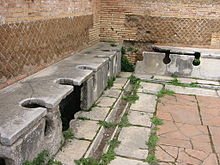



The xylospongiumortersorium, also known as a "sponge on a stick", was a utensil found in ancient Roman latrines, consisting of a wooden stick (Greek: ξύλον, xylon) with a sea sponge (Greek: σπόγγος, spongos) fixed at one end.
Academics disagree as to its exact use, about which the primary sources are vague. It has traditionally been assumed to be a type of shared anal hygiene utensil used to wipe after defecating, and the sponge cleaned in vinegar or water (sometimes salt water).[1][2][3][4] Other recent research suggests it was most likely a toilet brush.[5]
In the Baths of the Seven SagesinOstia, a fresco from the 2nd century contains the Inscription (u)taris xylosphongio[6] which is the first known mention of the term. Also in the early second century a papyrus letter of Claudius Terentianus to his father Claudius Tiberianus uses the term xylespongium in a phrase.[7]
In the middle of the first century, the Roman philosopher Seneca the Younger reported that a Germanic gladiator committed suicide with a sponge on a stick. According to Seneca, the gladiator hid himself in the latrine of an amphitheatre and pushed the wooden stick into his oesophagus and choked to death.[8]